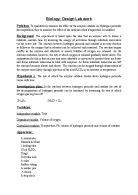Research Question
What is the effect of substrate (hydrogen peroxide) concentration on the rate of reaction between hydrogen peroxide and catalase?
Hypothesis
I believe that as the substrate concentration (hydrogen peroxide concentration) increases that rate of reaction will also increases. However, as it reaches the maximum substrate concentration, when all active site are full and working at maximum efficiency. As a result, any increase in substrate concentration beyond the maximum point will have no added effect as there are no extra active sites that can be used.
Variables
※Volume of oxygen gas released in 10 seconds
※Hydrogen peroxide concentration: 0%, 1%, 5%, 10%, 15%, 20%
※The temperature of the hydrogen peroxide and catalase is kept at room temperature which is about 23.5℃ when I measured it. By keeping the temperature constant can prevent it acting as a contributing factor that will affect the reliability of my results.
※Throughout the experiment, I will only be using 1% catalase solution.
※The volume of catalase (3ml) and hydrogen peroxide(2ml) is to be keep constant 3ml catalase, by using measuring cylinders.
※Time – I will only measure the amount of oxygen produced in the first 10 seconds of the reaction.
※pH level of hydrogen peroxide concentration:
source: http://h2o2.com/faqs/FaqDetail.aspx?fId=26
As shown from the table above, different concentration of hydrogen peroxide has different pH level. It can’t be possible for me to keep the pH level of hydrogen peroxide constant while changing its concentration; therefore even though pH level may affect the rate of enzyme activity, I cannot control the pH level as the change in pH level may also change the concentration of hydrogen peroxide.
Apparatus
- 1% catalase – 3ml x 25 (75ml in total)
- hydrogen peroxide (1%, 5%, 10%, 15%, 20%) – 2ml x 5 for each concentration: 10ml in total
- 2 measuring cylinders (10ml) and 1 pipette
- 2 beakers (50ml) and 1 conical flask (50ml)
-
1 glass syringe (100cm3)
- 10 test tubes and a test tube rack
- 1 ring stand
- 1 delivery tube and 1 stopper and blu tack
- 1 stopwatch
- safety goggle and plastic gloves
Risk Assessment
This procedure uses hydrogen peroxide. Wear safety goggle and plastic gloves.
Method
-
Gather all needed apparatus and set it up like the picture beside. Rinse all equipment and place test tube in the test tube rack. Attach the glass syringe firmly on to the clamp of the ring stand and connect the delivery tube to the tip of the glass syringe and connect the other side of the delivery tube with a stopper to the conical flask, use blu tack to seal the junctures.
- Prepare 15ml of 1% catalase and 10ml of 20% hydrogen peroxide.
- Use measuring cylinder and pipette to get 3ml of 1% catalase and 2ml of 20% hydrogen peroxide. Check the measurements at eye level to ensure that the measurements are exact. And pour each solution into a test tube. Repeat this for 5 times.
- Pour the catalase into the conical flask. Pour a test tube that contains 2ml of 20% hydrogen peroxide into the conical flask.
- Have the stopwatch ready and quickly cover the conical flask with the stopper that is attached to the delivery tube and immediately at timing with the stopwatch
- When the time almost reaches to 10 seconds keep your eyes close to the plunger for the amount of oxygen produced. Pull the stopper out from the flask and record the result down.
-
Push the plunger back and rinse conical flask
- Repeat steps 2 to 9 for five times for each different hydrogen peroxide concentration.
(Rinse beaker once you change the concentration of hydrogen peroxide)








